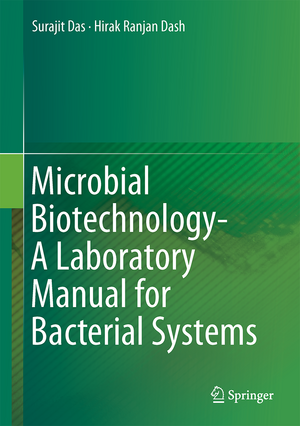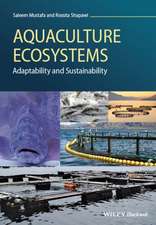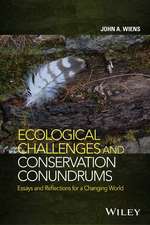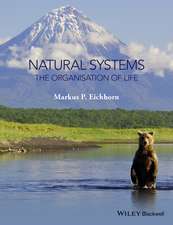Microbial Biotechnology- A Laboratory Manual for Bacterial Systems
Autor Surajit Das, Hirak Ranjan Dashen Limba Engleză Hardback – 5 dec 2014
| Toate formatele și edițiile | Preț | Express |
|---|---|---|
| Paperback (1) | 562.91 lei 38-44 zile | |
| Springer India – 10 sep 2016 | 562.91 lei 38-44 zile | |
| Hardback (1) | 649.22 lei 6-8 săpt. | |
| Springer India – 5 dec 2014 | 649.22 lei 6-8 săpt. |
Preț: 649.22 lei
Preț vechi: 763.78 lei
-15% Nou
Puncte Express: 974
Preț estimativ în valută:
124.23€ • 135.36$ • 104.68£
124.23€ • 135.36$ • 104.68£
Carte tipărită la comandă
Livrare economică 23 aprilie-07 mai
Preluare comenzi: 021 569.72.76
Specificații
ISBN-13: 9788132220947
ISBN-10: 8132220943
Pagini: 250
Ilustrații: XVI, 239 p. 143 illus., 86 illus. in color.
Dimensiuni: 178 x 254 x 17 mm
Greutate: 0.66 kg
Ediția:2015
Editura: Springer India
Colecția Springer
Locul publicării:New Delhi, India
ISBN-10: 8132220943
Pagini: 250
Ilustrații: XVI, 239 p. 143 illus., 86 illus. in color.
Dimensiuni: 178 x 254 x 17 mm
Greutate: 0.66 kg
Ediția:2015
Editura: Springer India
Colecția Springer
Locul publicării:New Delhi, India
Public țintă
ResearchCuprins
Preface.- Part I: Basic Molecular Microbiology of Bacteria.- Part II: Cloning and Transformation.- Part III: Advanced Molecular Microbiology Techniques.- Part IV: Molecular Microbial Diversity.- Part V: Computer Aided Study of Molecular Microbiology.- Part VI: Application of Molecular Microbiology.- References.- Further Readings.
Notă biografică
Surajit Das is an Assistant Professor at the Department of Life Science, National Institute of Technology, Rourkela, Orissa, India since 2009. Earlier he served at Amity Institute of Biotechnology, Amity University Uttar Pradesh, Noida, India. He received his Ph.D. in Marine Biology (Microbiology) from Centre of Advanced Study in Marine Biology, Annamalai University, Tamil Nadu, India. He has been the awardee of Endeavour Research Fellowship of Australian Government for carrying out Postdoctoral research at University of Tasmania on marine microbial technology. He has multiple research interests with core research program on marine microbiology. He is currently conducting research as the group leader of Laboratory of Environmental Microbiology and Ecology (LEnME) on biofilm based bioremediation of PAHs and heavy metals by marine bacteria, metagenomic approach for drug discovery from marine microorganisms, nanoparticle-based drug delivery and bioremediation; and the metagenomic approach for exploring the diversity of catabolic gene and immunoglobulins in the Indian Major Carps, with the help of research grants from the Department of Biotechnology (DBT), Ministry of Science and Technology and the Indian Council of Agricultural Research (ICAR), Government of India. Recognizing his work, National Environmental Science Academy, New Delhi had conferred 2007 Junior Scientist of the year award on marine microbial diversity. He is the recipient of Young Scientist Award in Environmental Microbiology from Association of Microbiologists of India in 2009. Dr. Das is also the recipient of Ramasamy Padayatchiar Endowment Merit Award given by Government of Tamil Nadu for the year 2002-2003 from Annamalai University. He is the member of IUCN Commission of Ecosystem Management (CEM), South Asia and life member of the Association of Microbiologists of India, Indian Science Congress Association, National Academy of Biological Sciences and National Environmental Science Academy, NewDelhi. He is also the member of the International Association for Ecology. He is the reviewer of many scientific journals published by reputed publishers. He has written three books and authored more than 40 research publications in leading national and international journals on different aspects of microbiology.
Hirak Ranjan Dash is a Senior Research Fellow at Laboratory of Environmental Microbiology and Ecology (LEnME), Department of Life Science, National Institute of Technology, Rourkela, Odisha, India. He did his M. Sc. Microbiology (2010) from Orissa University of Agriculture and Technology, Bhubaneswar, Odisha, India. Currently, he is continuing his research on diversity and genetic aspects of mercury resistant marine bacteria for enhanced bioremediation of mercury. He has also worked in the field of antibiotic resistance and genotyping of pathogenic Vibrio and Staphylococcus spp. During his research work, he has isolated many potent mercury resistant marine bacteria fromBay of Bengal, Odisha and utilised in mercury bioremediation. A number of microbiological technique has also been developed by him for monitoring the level of mercury pollution in the marine environment. A novel mechanism of mercury resistance i.e. by intracellular biosorption was reported by him in the marine bacterial isolates. He has constructed transgenic marine bacteria possessing both mercury biosorption and volatilization capability for utilization in mercury bioremediation. He has published 14 research papers, 7 book chapters and 10 conference proceedings in his credit.
Hirak Ranjan Dash is a Senior Research Fellow at Laboratory of Environmental Microbiology and Ecology (LEnME), Department of Life Science, National Institute of Technology, Rourkela, Odisha, India. He did his M. Sc. Microbiology (2010) from Orissa University of Agriculture and Technology, Bhubaneswar, Odisha, India. Currently, he is continuing his research on diversity and genetic aspects of mercury resistant marine bacteria for enhanced bioremediation of mercury. He has also worked in the field of antibiotic resistance and genotyping of pathogenic Vibrio and Staphylococcus spp. During his research work, he has isolated many potent mercury resistant marine bacteria fromBay of Bengal, Odisha and utilised in mercury bioremediation. A number of microbiological technique has also been developed by him for monitoring the level of mercury pollution in the marine environment. A novel mechanism of mercury resistance i.e. by intracellular biosorption was reported by him in the marine bacterial isolates. He has constructed transgenic marine bacteria possessing both mercury biosorption and volatilization capability for utilization in mercury bioremediation. He has published 14 research papers, 7 book chapters and 10 conference proceedings in his credit.
Textul de pe ultima copertă
Microorganisms play an important role in the maintenance of the ecosystem structure and function. Bacteria constitute the major part of the microorganisms and possess tremendous potential in many important applications from environmental clean up to the drug discovery. Much advancement has been taken place in the field of research on bacterial systems. This book summarizes the experimental setups required for applied microbiological studies. Important background information, representative results, step by step protocol in this book will be of great use to the students, early career researchers as well as the academicians. The book describes many experiments covering the basic microbiological experiments to the applications of microbial systems for advanced research. Researchers in any field who utilize bacterial systems will find this book very useful. In addition to microbiology and bacteriology, this book will also find useful in molecular biology, genetics, and pathology and thevolume should prove to be a valuable laboratory resource in clinical and environmental microbiology, microbial genetics and agricultural research.
Unique features
· Easy to follow by the users as the experiments have been written in simple language and step-wise manner.
· Role of each reagent to be used in each experiment has been described which will help the beginners to understand quickly and design their own experiment.
· Each experiment has been equipped with the coloured illustrations for proper understanding of the concept.
· Trouble-shootings at the end of each experiment will be helpful in overcoming the problems faced by the users.
· Flow-chart of each experiment will quickly guide the users in performing the experiments.
Unique features
· Easy to follow by the users as the experiments have been written in simple language and step-wise manner.
· Role of each reagent to be used in each experiment has been described which will help the beginners to understand quickly and design their own experiment.
· Each experiment has been equipped with the coloured illustrations for proper understanding of the concept.
· Trouble-shootings at the end of each experiment will be helpful in overcoming the problems faced by the users.
· Flow-chart of each experiment will quickly guide the users in performing the experiments.
Caracteristici
Step by step protocol to help the researchers perform the experiments Comprehensive explanation of the fundamentals behind each procedure and the role of each chemical used will aid the researchers to further modify and customize the experiments according to their needs Specific trouble shooting guidelines for each experiment Includes supplementary material: sn.pub/extras












